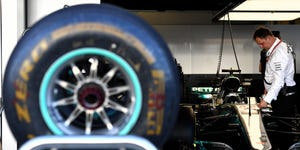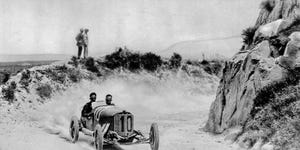Formula 1 is nothing if not technologically advanced. What you see on the surface does little to give away how much time and effort goes into every detail of the car and the sport. Yes, at the end of the day, it’s the same as any race: Whoever is fastest wins. But what engineers do to achieve that end is truly remarkable.
The Mercedes F1 team’s dual-axis steering is a perfect example of that. Using longitudinal motion in the steering column to allow drivers to adjust the toe-angle of tires is truly impressive. But even that only begins to describe the work involved in the Mercedes steering system. According to formula1.com, dual-axis steering is an expansion of an existing technology used in 2019 called the twin rack and pinion, which gave engineers two ways to adjust the Ackermann Effect. And adjusting that effectively adjusted toe-angle.
Let’s back up: The Ackermann Effect is a geometry built into the steering system of every modern passenger car sold today. It’s a mechanism that turns the inside wheel more than the outside while steering around the corner. Why? If you visualize the geometry of a turn, the inside wheel is taking a tighter corner than the outside and needs to turn more.

The Ackermann Effect plays an important role in initial turn-in because it effectively changes the steering angle. But it also comes with inherent compromises. More Ackermann Effect means more stability in cornering and improved performance in tight corners—like, say, the hairpin at Monaco—but it also hurts aerodynamic performance while cornering and increases tire wear.
The Mercedes twin rack and pinion got around this by using a hydraulic piston attached to the steering rack. When the driver steered beyond a certain angle, it engaged the hydraulic piston that enacted a second steering rack that increased the steering angle on just the inside wheel. In other words, Mercedes had one setting for faster corners and a second, more aggressive one for slower corners.

This meant the nominal setup of the car could be less extreme to put less strain on the tire and increase the effectiveness of the aerodynamics in the faster corners. Quite simply, it made the car faster. Of course, Ferrari discovered what Mercedes was doing and adopted a similar strategy.
That kind of detail is applied to every part of a Formula 1 car, which helps explain why money plays such a big part in the sport.
Source: Read Full Article
